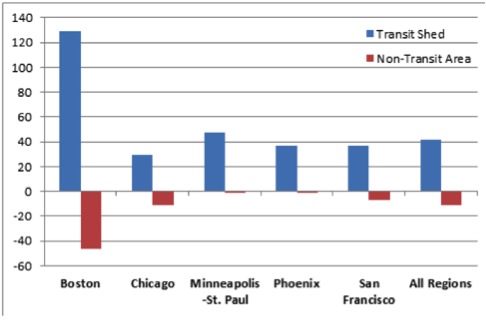
If you live close to a transit station, chances are you’ve weathered the recession better than your friends who don’t.
Your transportation costs are probably lower, since you can take transit instead of driving. Transit-served areas are usually more walkable and bikeable too, multiplying your options. And while home values plummeted during a recession that was triggered by a massive housing bubble, your home probably held its value relatively well – if you live near transit.
The National Association of Realtors and the American Public Transportation Association commissioned the Center for Neighborhood Technology to study the impact of transit access on home values during the recession. For the report, "The New Real Estate Mantra: Location Near Public Transportation" [PDF], CNT looked at five metro regions -- Boston, Chicago, Minneapolis-St. Paul, Phoenix, and San Francisco.
While nearly everyone in hard-hit cities experienced some setback from tanking housing prices, transit-served areas were largely insulated from the worst of it, CNT found:
Across the study regions, the transit shed outperformed the region as a whole by 41.6 percent. In all of the regions the drop in average residential sales prices within the transit shed was smaller than in the region as a whole or the non-transit area. Boston station areas outperformed the region the most (129 percent), followed by Minneapolis-St. Paul (48 percent), San Francisco and Phoenix (37 percent), and Chicago (30 percent).
This is consistent with a study released last year by the Center for Housing Policy showing that access to rail transit created a “transit premium” for nearby home values of between six and 50 percent. That study, like CNT's, looked at Minneapolis and Chicago, as well as Portland. The Center for Transit Oriented Development has also looked at this phenomenon and found transit premiums as high as 150 percent.
Not surprisingly, not all transit types fared the same in CNT’s research. Stations with frequent service that are part of a well-connected transit network gave the biggest boost to home values. Those households, naturally, have better access to jobs and lower transportation costs.
Additionally, there's variation because different types of transit serve different types of neighborhoods. Commuter rail station neighborhoods tend not to be as walkable and compact as those served by high-frequency, well-connected transit like subways, light rail, or BRT -- and one WalkScore point reportedly worth an additional $3,000 in a home’s value. In examining office rents in walkable and non-walkable areas, real estate developer Chris Leinberger attributed two-thirds of the walkable areas’ better performance to walkability.

Phoenix is not known for being a transit-rich city. Indeed, only 2 percent of the region’s households live within a half-mile walk of a Metro station. Even within the transit shed, just 9.1 percent of workers commute via transit. Still, even a relatively weak transit system showed substantial benefits for nearby homeowners: Their home values outperformed the area by 36.8 percent, with apartments faring the best.
Apartment living also paid off in Boston, a far more transit-rich city, where a third of workers with transit access use it to get to work – and more than half of transit-served residents commuting via transit, biking, or walking. Those folks didn’t just save on transportation – their home values fared 226.7 percent better than the region as whole if they were served by rapid transit. Homes served by commuter rail actually declined even more than the regional average, even in relatively close-in areas. As in Phoenix, apartments lost the least value.
In Chicago, home prices dropped by nearly a third between 2006 and 2011, but if you lived near transit, your home lost almost 30 percent less value than the region at large – especially if you lived near the L, in which case you did 47.3 percent better. Commuter rail-served areas got a somewhat smaller boost at 22.7 percent. In Chicago, it was townhouses, not apartments, that saw the smallest decline.
San Francisco has the most widely-used transit service of any of the study areas, with 40 percent of workers with transit access riding it to get to work and another 21 percent walking or biking. San Francisco’s housing prices were among the hardest hit of the five regions, but those served by Muni outperformed the rest of the region by 61.6 percent. BART access added only about 35 percent, with transit access in general helping boost home values, relative to the region as a whole, by 37.2 percent.





